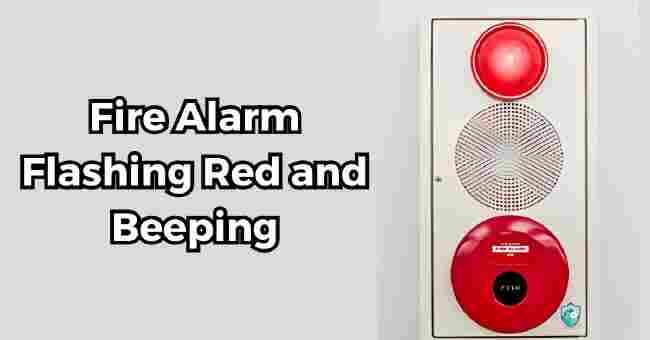Table of Contents
Have you ever been jolted awake by the sudden, puncturing sounds of your fire alarm flashing red and beeping? It’s unsettling, sparking fears of raging fires and potential danger.
I experienced this recently, alarmed to see smoke pouring from my kitchen as the alarm sang an eerie tune. After evacuating swiftly, I realized it was simply steam from an overboiled pot triggering this sensory spectacle.
Still, the experience highlighted the importance of decoding these signals, rather than panicking each time our guardians warn of danger both real and perceived. By understanding their language, we can respond appropriately when alarms sound their siren song.
Now, Let’s explore what sparks this sensory spectacle and how you can act when the smoke detector starts dancing.
The Conductor Calling the Shots: What Triggers Fire Alarm Flashing Red And Beeping
Your fire alarm is the silent conductor of your home’s safety orchestra, ready to cue the music if flames ever threaten your haven.
But what exactly makes it leap into action? Let’s look at the common triggers that set alarms singing:
Heat Sensors: Detect rapidly rising temperatures from fires and trigger the alarm.
Smoke Sensors: Sense smoke particles from combustion and alert residents to danger.
Flashing Light: Visually signals high heat, smoke, or other alarm triggers.
Loud Beeping: Audibly alerts residents to potential danger so they can escape.
Low Battery: As battery runs low, intermittent beeps and flashes remind you to replace it.
End of Life: Outdated alarms send erratic signals, indicating they should be replaced.
External Factors: Issues with wiring, power outages, WiFi connectivity problems or damage from pests can also spark false signals.
Understanding what makes your alarm tick helps you quickly identify threats versus harmless triggers like cooking smoke.
Arm yourself with knowledge before the sparks fly. Now, let’s decode the most common sensory symphonies your alarm performs and how to react.
1. The Low Battery Blues: A Subtle, Rhythmic Reminder
The most familiar refrain your alarm will sing sounds something like this:
- A soft beep every 30 to 60 seconds
- Accompanied by a steady red blinking light
- Occurring regularly until the batteries are replaced
This gentle cue is your alarm’s way of humming, “Heads up, my batteries are feeling drained. Time to freshen up!”
Here are some battery basics to ensure your alarm’s voice stays strong:
Battery Type
- Identify which specific batteries your model requires (usually printed on alarm).
- Alkaline batteries are generally best for smoke alarms.
Freshness First
- Don’t use old batteries – their capacity and voltage may be reduced.
- Choose name brand or lithium batteries for longest life.
Mind the Polarity
- Note battery’s positive and negative orientation.
- Match polarity symbols on battery to those on alarm.
Mark Your Calendar
- Set bi-annual reminders to swap batteries, even if alarm seems fine.
- Coordinate with daylight savings clock changes.
While the low battery blues might seem like a nuisance, this gentle tune reminds you to keep your alarm singing at full volume.
Silence could be deadly in an emergency, so don’t dismiss the cue.
2. The Smoke and Mirrors Waltz: A Frantic Call to Action
Imagine the melody shifts and the beeping accelerates rapidly. The lights flash urgently as smoke pours from the kitchen. This spirited smoke detector dance means business!
Smoke Sensor Activation
- Optical: Detects smoke particles blocking receptor light beam.
- Ionization: Senses trace smoke compounds altering sensor current.
Alarm Signals
- Rapid beeping, flashing lights
- Persistent cues rising in urgency
Your Move
Evacuate immediately using your emergency plan. Don’t delay!
Exit Tips
- Crawl low under smoke
- Use back of hand to check for hot doors
- Mark windows as you exit
- Meet at designated spot
The smoke and mirrors waltz is no warm up. Treat all signals seriously and make your safety top priority every time that alarm siren sings!
3. The Faulty Wiring Funk: When Rhythm Meets Discord
What if the tune turns discordant – strange beeping patterns, lights dimming erratically, the whole system singing out of whack?
Before you panic, consider whether faulty wiring or connectivity issues might be throwing your alarm’s rhythm off:
Power Related Issues
- Faulty, damaged, or overloaded electrical wiring
- Tripped breakers or blown fuses
- Power outages
Connectivity Problems
- WiFi network errors or outages
- Physical damage to alarm wires
- App syncing problems
Don’t ignore these warning signs! Just like spotting a limping musician, identifying issues early allows ample time for diagnosis and repair before performance night arrives.
Consider seeking a professional electrician to inspect wiring and restore power stability to your home orchestra.
Review WiFi connectivity and physical damage that could impact alarm signals.
The B Side: Uncovering the Untold Tales of Alarm Batteries
They may be B side players in the story of your fire alarm, but don’t underestimate the unsung power of batteries.
Part operator, part orchestra, these crucial components convert stored chemical energy into the power required to sound the alarm.
Let’s amplify their key role in keeping your alarm ready to sing:
Match the Type
- Most alarms require 9 volt alkaline batteries
- Choose the specified type to optimize performance
Cheat Sheet for Common Types
| Battery | Features | Typical Use |
|---|---|---|
| Carbon zinc | Lowest cost | Toys, remotes |
| Alkaline | Good value and stability | Smoke alarms, electronics |
| Nickel metal hydride | Rechargeable | Tools, gadgets |
| Lithium | Lightweight, long life | Cameras, smart home devices |
Freshness Dates and Shelf Life
Storing replacement batteries properly helps preserve longevity:
- Write purchase dates on batteries using a marker
- Discard after expiration date
- Ideal storage temperature is around 59-77°F
- Storing at extreme temps hastens self discharge
With the B side batteries pulling their weight, your alarm system remains powered up and ready to sing at full force.
The Smoke and Flames Fandango: Assessing Real Fire Risks
While alarms deal mainly in signals and sounds, actual home fires are no abstraction.
In most cases when the smoke tango gets going and flames fan across floors and walls, critical action on the part of residents makes all the difference.
Let’s look at some stats on the risks and measures you can take:
Fast Fire Facts
According to the National Fire Protection Agency (NFPA):
- A home fire is reported every 90 seconds in the U.S.
- Around 2,630 people die in home fires each year.
- Another 10,970 are injured in home blazes annually on average.
- Roughly $7 billion in property damage stems from home fires each year.
- Cooking equipment is the #1 cause of house fires and related injuries.
Clearly no joking matter, anticipated action is key to preventing catastrophe and damage.
Fire Fighting Tips
- Allow ample clearance between ignition sources and combustibles
- Look for NFPA 701 flame retardant labels on fabrics
- Ensure your local fire department’s number is saved in phones
- Position fire extinguishers strategically around home
- Practice stop, drop and roll techniques regularly
Forewarned is forearmed! Coupling knowledge with preparation helps make the smoke and flames fandango a rare, rather than regular routine occurrence.
Intermission: Pit Stop Tips To Optimize Your Alarm Overture
Think of your fire alarm as a veteran musician accustomed to performing on cue. To keep it crooning smoothly take heed of these pit stop pointers:
Conduct Sound Checks
- Test alarms monthly
- Replace batteries every 6 months
- Address any issues promptly
Consider Connected Alarms
- Interlinked systems enhance early warning
- Allows alarms to synchronize signals
- Features tamper proofing options
Consult the Conductor’s Notes
- Save manual for reference
- Details correct positioning guidelines
- Provides battery specifications
Call In the Crew
- Seek professional help for wiring woes
- Upgrade outdated alarm systems
- Ensure proper installation
With periodic tune-ups, your system sings safely for years to come!
4. The Faulty Sensor Suites: Identifying the Root of Intermittent Issues
In some cases, your alarm’s signals may seem unreliable or intermittent. Before you blame phantoms, consider what’s triggering these false alarms:
Main Offenders
- Dust, dirt or insect debris blocking sensors
- Steam, smoke or fumes in alarm vicinity
- Issues with sensors or malfunctioning units
Solutions
- Carefully vacuum alarm exterior
- Clean sensors gently if needed
- Clear cooking vapors promptly
- Replace defective units
Don’t just silence errors and ignore problems in your safety suite. Getting to the root of issues ensures your system detects real threats early and acts decisively.
5. The Expired Elegy: Knowing When to Call Time
As with any veteran musician, your trusted fire alarm will inevitably reach retirement age.
Gradual sound deterioration, inconsistent light flashing and other lapses in performance indicate your alarm orchestra needs fresh blood.
Heed the expiration elegy by:
- Noting manufacture date printed on most units
- Replacing alarms over 10 years old per NFPA guidelines
- Choosing reliable, reputable replacement models
- Properly installing and testing new alarms
Relying on expired equipment leaves you vulnerable when genuine threats emerge. So salute your veterans’ service, but don’t hesitate to usher in new recruits!
Encore: Essential Escape Tips When Your Alarm Steals the Show
While preventing fires is ideal, preparation is key for when prevention fails and emergency strikes. Use these tips to choreograph a smooth, safe evacuation:
Make Regular Practices a Priority
Drill escape plans frequently so everyone remembers their role when pressure peaks.
Designate Meeting Places
Choose a fixed spot where everyone reconvenes after exiting to enable swift head counts.
Know Two Exit Paths From Every Room
Identify primary and secondary routes in advance since main paths may be obstructed.
Remember Safety Fundamentals
Stay low, check doors for heat, hold your breath to avoid smoke inhalation.
Invest in Emergency Ladders
Position escape ladders in upper level rooms for backup if stairwells are blocked.
With some advance choreography, you can finesse a graceful exit when disasters strike and alarms sound their siren song.
Bravo for making it to the final act of our fire alarm decoding journey.
Let’s recap the top takeaways:
- Learn your alarm’s sensory signals and how to react
- Replace batteries and test systems regularly
- Address wiring issues and connectivity promptly
- Replace expired or defective models right away
- Make fire escape drills a household priority
I hope this exploration of what sparks false alarms demystifies their signals and empowers smarter responses. Understanding their language lets you separate threats from routine chatter.
FAQs
Why Is The Red Light On My Fire Alarm Always On?
A constantly glowing red light on a fire alarm often indicates that the alarm is powered up and functioning normally.
This red LED light acts as a visual cue and will typically flash brightly when the alarm detects smoke or carbon monoxide as an additional alert.
Some key reasons for the red light being constantly on include:
- Working, wired-in alarm is powered up
- Battery is correctly installed and operating
- Normal default mode when no danger is detected
- Confirms your alarm is active and ready if an emergency occurs
So in most cases, a persistent red glow is nothing to worry about – it just means your fire alarm is powered on standby mode.
However, if the red light begins flashing brightly, making loud beeping noises, or the light seems exceptionally dull, it could signify issues needing attention.
What Does It Mean When A Fire Alarm Blinks From Green To Red?
Many newer fire alarm models feature dual indicator lights – a green LED that signifies normal operation on standby power, along with a red one for when warnings are triggered.
Seeing your alarm blink from an initial green light to an intermittent or steady red glow can have several implications:
- The unit detected smoke, heat or carbon monoxide
- Sensor tests indicate declining battery voltage
- There may be connectivity issues with a linked alarm system or WiFi network
- Malfunctions or errors in alarm wiring and mechanisms
In any of these cases, a green to red blink is cause for attention. Smoke alarms warrant swift action to address the potential emergency and troubleshoot any underlying equipment issues. Stay alert to this visual cue.
How Do I Stop My Fire Alarm From Beeping Without A Battery?
For hardwired fire alarms connected to your home’s electrical system without a battery backup, a low voltage short could cause intermittent beeping even with no battery installed.
Potential solutions include:
- Flipping circuit breakers off and on to reset the alarm
- Making sure wiring connections are secure
- Testing voltages to check for shorts
- Replacing old, defective alarms
- Hiring an electrician to diagnose wiring faults
Persistent beeping without a battery generally indicates a wiring, connectivity or malfunction problem.
The exact cause needs to be addressed – covering alarms or disconnecting them leaves you vulnerable without this important protective system.
How Do I Silence My Fire Alarm Battery?
If your battery-powered smoke detector frequently emits nuisance low battery beeps or chirping sounds, you likely need to replace the aging battery.
However, in a pinch, holding down the alarm “Test” button for up to 15 seconds can temporarily silence some battery models.
Just be very careful only to mute actual false alarms and low battery alerts. Never silence an actively sounding fire alarm without first addressing the potential emergency and ensuring there is no present danger.
Your safety comes first when smoke signals sound.
How Do I Stop My Fire Alarm Beeping Every 30 Seconds?
A fire alarm beeping every 30 seconds is almost always caused by a low backup battery that powers the alarm in case of electrical failure. Follow this process to stop the beeps:
- Press the alarm test button to confirm it still works
- Note whether a red LED light is also blinking
- Identify battery type printed on the unit
- Replace old batteries with fresh ones
- Reattach unit and test to verify beeping stops
Skipping battery changes leaves your home and family unprotected. So replace cells promptly when you hear the low battery warning every 30 seconds.
Just be sure to use the manufacturer recommended alkaline or lithium batteries for longest performance.
What Does It Mean If Your Fire Alarm Keeps Beeping?
If your smoke alarm emits loud, frequent beeps unaccompanied by any apparent threat or danger, this persistent sound most likely signals:
- Dying or depleted batteries
- Buildup of dirt, dust and debris
- Malfunctioning, defective or outdated alarms
- Nearing the 10-yearrecommended replacement date
Any of these issues can trigger nuisance beeping episodes. It’s essential to pinpoint the cause then promptly replace batteries, clean sensors, or install new modern alarm systems to maintain critical, lifesaving protection.
How Long Does A Fire Alarm Beeping Last?
Smoke detector beeping can persist anywhere from a few minutes during a false alarm to hours or even weeks if underlying issues like low batteries or malfunctions are ignored.
Here’s a breakdown of typical alarm beeping duration:
- False alarms from cooking, steam – 1 to 3 minutes
- Low battery warnings – Beeps every 30 seconds, repeating for weeks until the battery dies without replacement
- Sensor contamination – Intermittent beeping that recurs until cleanup
- Defects and end of life – Escalating, erratic beeps lasting days to months
While momentary false episodes will self-resolve, repeated or long lasting beeps require attention. Never ignore consistent warnings over 48 hours – take action to address the cause.
Why Is My Fire Alarm Beeping Repeatedly?
Intermittent but repeating fire alarm beeps tend to indicate one of these common issues is present:
- Dirt, dust or dead insects in sensors triggering errors
- High humidity and steam from hot showers or cooking
- Declining backup battery voltage below optimum level
- Age related glitches in outdated alarm systems
Start troubleshooting by cleaning alarm covers and vents using compressed air or a vacuum hose attachment. Replace low batteries promptly as well.
If cleaning and new batteries don’t stop recurring beeps, installing a replacement alarm is wise. Never ignore repeating warnings.
How Do You Turn Off A Fire Alarm?
Most fire alarms feature a simple on/off switch or enable you to take out the battery or circuit breaker powering them.
However, it’s wise never to deactivate an actively sounding alarm without first addressing the potential threat.
Your reaction steps if an alarm is triggering should be:
- Evacuate the building and get to safety
- Call 911 to report the potential fire or carbon monoxide leak
- Only after the all clear, deactivate the alarm system by flipping its on/off switch, pressing a reset button, or removing the battery
Never silence an alarm that is serving its purpose to warn you of danger.
Always address the trigger first, get to safety and call emergency responders if needed before powering down the unit.
Your life is worth more than a brief alarm disturbance.
Conclusion
As we’ve explored, a fire alarm’s blinking light and beeping tones carry vital messages to guide our safety response.
Whether caused by actual emergencies or harmless triggers like cooking smoke, these signals warrant attention and measured action.
Remember to test alarms regularly, replace low batteries promptly, and evacuate carefully whenever alarms sound, whether threats prove real or perceived. Stay safe out there.




